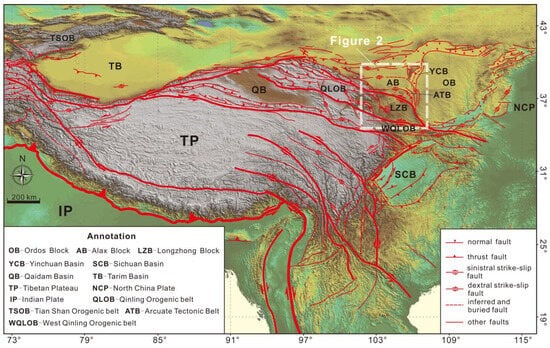JMSE, Vol. 13, Pages 170: The Formation and Modification of the Arcuate Tectonic Belt in the Northeastern Tibetan Plateau: Insight from Three-Dimensional Finite Element Numerical Simulation
Journal of Marine Science and Engineering doi: 10.3390/jmse13010170
Authors:
Yilin Zhao
Wei Shi
Yujun Sun
Guiting Hou
The arcuate tectonic belt in the northeast Tibetan Plateau has been a contentious topic regarding its formation and evolution, owing to its distinctive geological structure as the lateral growth boundary of the plateau. In this research, leveraging geological and geophysical data, a three-dimensional finite element numerical model is employed to explore the impact of lateral and vertical inhomogeneities in lithospheric strength on the northeast Tibetan Plateau’s growth and the arcuate tectonic belt’s formation and alteration. Additionally, the kinematic and deformation traits of the arcuate tectonic belt, such as regional motion velocity, stress, and crustal thickness during shortening and strike-slip deformation, are comparatively analyzed. The findings indicate that the arcuate tectonic belt takes shape when the weakly strengthened Tibetan Plateau is impelled into the Yinchuan Basin after being obstructed by the robust Alax and Ordos blocks during lateral expansion. Intense shear deformation occurs at the block boundaries during the arc tectonic belt’s formation. The weak middle-lower crust, serving as a detachment layer, facilitates the plateau’s lateral growth and crustal shortening and thickening without perturbing the overall deformation characteristics. It is verified that the arcuate tectonic belt was formed during the NE-SW compression phase from around 9.5 to 2.5 Ma, accompanied by significant crustal shortening and thickening. Since 2.5 Ma, within the ENE-WSW compression process, the internal faults of the arcuate tectonic belt are predominantly strike-slip, with no pronounced crustal shortening and thickening. Only local topographical modification is conspicuous. This study will enhance our comprehension of the Tibetan Plateau’s uplift and lateral growth process and furnish a foundation for investigating the formation of arcuate tectonic belts.
Source link
Yilin Zhao www.mdpi.com

